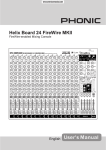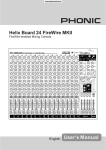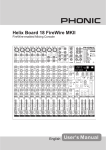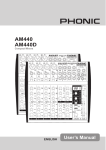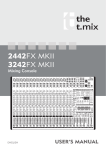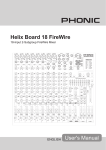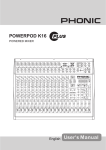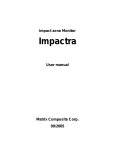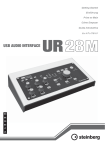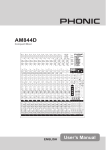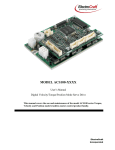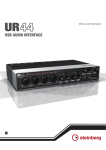Download Manual
Transcript
Helix Board 24 Universal USB- and FireWire-enabled Mixing Console IMPORTANT SAFETY INSTRUCTIONS The apparatus shall not be exposed to dripping or splashing and that no objects with liquids, such as vases, shall be placed on the apparatus. The MAINS plug is used as the disconnect device, the disconnect device shall remain readily operable. Warning: the user shall not place this apparatus in the can be easily accessible. area during the operation so that the mains switch 1. Read these instructions before operating this apparatus. CAUTION 2. Keep these instructions for future reference. RISK OF ELECTRIC SHOCK DO NOT OPEN 3. Heed all warnings to ensure safe operation. 4. Follow all instructions provided in this document. 5. Do not use this apparatus near water or in locations where condensation may occur. 6. Clean only with dry cloth. Do not use aerosol or liquid cleaners. Unplug this apparatus before cleaning. 7. Do not block any of the ventilation openings. Install in accordance with the manufacturer’s instructions. 8. Do not install near any heat sources such as radiators, heat registers, stoves, or other apparatus (including . 9. Do not defeat the safety purpose of the polarized or grounding-type plug. A polarized plug has two blades with one wider than the other. A grounding type plug has two blades and a third grounding prong. The wide blade or the third prong is provided for your safety. If the provided plug does not into your outlet, consult an electrician for replacement of the obsolete outlet. 10. Protect the power cord from being walked on or pinched particularly at plug, convenience receptacles, and the point where they exit from the apparatus. 11. Only use attachments/accessories manufacturer. by the 12. Use only with a cart, stand, tripod, bracket, or table by the manufacturer, or sold with the apparatus. When a cart is used, use caution when moving the cart/apparatus combination to avoid injury from tipover. 13. Unplug this apparatus during lighting storms or when unused for long periods of time. 14. Refer all servicing to service personnel. Servicing is required when the apparatus has been damaged in any way, such as power-supply cord or plug is damaged, liquid has been spilled or objects have fallen into the apparatus, the apparatus has been exposed to rain or moisture, does not operate normally, or has been dropped. CAUTION: TO REDUCE THE RISK OF ELECTRIC SHOCK, DO NOT REMOVE COVER (OR BACK) NO USER SERVICEABLE PARTS INSIDE REFER SERVICING TO QUALIFIED PERSONNEL The lightning flash with arrowhead symbol, within an equilateral triangle, is intended to alert the user to the presence of uninsulated “dangerous voltage” within the product’ magnitude to constitute a risk of electric shock to persons. The exclamation point within an equilateral triangle is intended to alert the user to the presence of important operating and maintenance (servicing) instructions in the literature accompanying the appliance. WARNING: To reduce the risk of or electric shock, do not expose this apparatus to rain or moisture. CAUTION: Use of controls or adjustments or performance of procedures other than those may result in hazardous radiation exposure. Helix Board 24 Universal USB- and FireWire-enabled Mixing Console INTRODUCTION........................................................................................................................... 4 FEATURES.................................................................................................................................... 4 PACKAGE INCLUDES.................................................................................................................. 5 GETTING STARTED..................................................................................................................... 5 CHANNEL SETUP.........................................................................................................................5 CONVERTING TO TABLE TOP MODE.........................................................................................6 INSTALLING THE RACK MOUNT KIT...........................................................................................7 MAKING CONNECTIONS ............................................................................................................8 INPUTS AND OUTPUTS ....................................................................................................8 MAIN MIXING PANEL .......................................................................................................10 CONTROLS AND SETTINGS......................................................................................................10 REAR PANEL ....................................................................................................................10 CHANNEL CONTROLS .................................................................................................... 11 DIGITAL EFFECT SECTION..............................................................................................12 MASTER SECTION ..........................................................................................................13 FIREWIRE PRE / POST SWITCHES ...............................................................................15 FIREWIRE INTERFACE...............................................................................................................16 SYSTEM REQUIREMENTS...............................................................................................16 DRIVER INSTALLATION....................................................................................................16 CHANNEL ASSIGNMENT..................................................................................................20 CUBASE LE ......................................................................................................................20 HELIX BOARD CONTROL PANEL .............................................................................................21 DIGITAL EFFECTS TABLE .........................................................................................................23 APPLICATION..............................................................................................................................24 SPECIFICATIONS . .....................................................................................................................26 DIMENSIONS...............................................................................................................................28 BLOCK DIAGRAM.......................................................................................................................29 Phonic preserves the right to improve or alter any information within this document without prior notice. V1.0 AUG 8th,2008 INTRODUCTION FEATURES Thank you for purchasing the Helix Board 24 Universal, one of Phonic’s newest mixers that sounds great and works hard both in the studio and on the road. The mixer features a USB and FireWire interface that can stream up to 18 independent channels of audio to the computer and return two tracks for monitoring, all at a 24-bit bit-rate and 96 kHz sampling rate. Also featured is an onboard 32/40-bit digital multi-effect processor providing 100 popular programs plus tap delay, testtones and foot switch jacks. The multi-directional Input/Output pod makes the device versatile; making rack mounting or table-top connections much easier. • 24-input analog mixer with extremely low noise circuitry There are sixteen extremely low noise Mic preamps, each with individual phantom power, and sixteen 1/4” phone jacks spread across the Helix Board 24 Universal 16 mono channels. Each channel features a 3-band EQ (with a sweepable mid control), AUX, EFX and Group sends, as well as a low-cut filter for removing troublesome stage-rumble. Additional features include AUX sends and returns, input and output soloing, four true subgroups, dedicated Mono/ Subwoofer output with selectable Low Pass Filter, S/ PDIF digital outputs, Steinberg Cubase LE workstation software and an included rack-mounting kit. We know how eager you are to get started – wanting to get the mixer out and hook it up to your computer is probably your number one priority right now – but before you do, we strongly urge you to take a look through this manual. Inside, you will find important instructions and warnings on the set up, use and application of your brand new Helix Board 24 Universal. If you do happen to be one of the many people who flatly refuse to read user manuals, then we just urge you to at least glance at the Instant Setup and FireWire Interface sections. After glancing at or reading through the manual (we applaud you if you do read the entire manual), please store it in a place that is easy for you to find, because chances are there’s something you missed the first time around. • 96kHz FireWire interface for streaming 18 independent channels of audio to computer with zero latency • 96kHz USB interface for streaming the first 16 input channels independently to the computer with zero latency • Pre/post switches for swapping streaming input channels to computer from pre low cut, EQ to post EQ, post fader • 2 channels of monitoring from computer via FireWire interface, can be assigned to control room monitors, main mix and AUX 1 • DFX, our 32/40-bit high definition algorithm digital multi-effect processor with 100 programs plus tap delay and foot switch jacks • 16 Mic/Line channels with inserts • 3-band EQ with swept mid-range • 75 Hz low-cut filter on each channel • AUX 1 & 2 with Pre/Post switch • Six AUX send mixing bus • Four stereo AUX returns, three with effect to monitor • +48V phantom power on Mic channels • Four true subgroups with main L and R routing switches • Direct outputs for multi-track recording • Control Room and Phones outputs with multi-input source matrix • Mono out with variable low pass filter from 60 Hz to 160 Hz for subwoofer • Dual-position I/O pod • Built-in switching power supply with universal connector, 100-240 VAC, 50/60 Hz • Rack-mounting kit included • 44.1k S/PDIF digital audio output • Compatible with Mac OSX and Windows XP / Vista • Steinberg Cubase LE 4.1.2 included Helix Board 24 Universal PACKAGE INCLUDES CHANNEL SETUP 1 x Helix Board 24 Universal mixer 1. 1 x FireWire cable 1 x USB cable 1 x CD-ROM with ASIO & WDM drivers 1 x CD-ROM with Steinberg Cubase LE 1 x Power cable 1 x Rack mounting kit If any items are missing from your package, please contact your local Phonic dealer GETTING STARTED 1. Ensure all power is turned off on your mixer. To totally ensure this, the AC cable should not be connected to the unit. 2. All faders and level controls should be set at the lowest level and all channels off to ensure no sound is inadvertently sent through the outputs when the device is switched on. All levels can be altered to acceptable degrees after the device is turned on using the channel setup instructions. 3. Plug any necessary equipment into the device’s various outputs. This could include amplifiers and speakers, monitors, signal processors, and/or recording devices. 4. Plug the supplied AC cable into the AC inlet on the back of the device and then into a power outlet of a suitable voltage. 5. Turn the power switch on and follow the channel setup instructions to get the most out of your equipment. Helix Board 24 Universal To ensure the correct audio level of the input channel is selected, each of the Mixer’s Channel’s ON buttons should be disengaged (which should turn the corresponding LED indicator off), as well as the Solo buttons on each channel and all buttons in the Control Room Source section, with exception to the Main L/R button. 2. Ensure the channel you wish to set has a signal sent to it similar to the signal that will be sent when in common use. For example, if the channel has a microphone connected to it, then you should speak or sing at the same level the performer normally would during a performance; if a guitar is plugged into the channel, then the guitar should also be strummed as it normally would be (and so on). This ensures levels are completely accurate and avoids having to reset them later. 3. Move the Channel fader and Maser fader to around the 0 dB mark. 4. Turn the Channel ON. 5. Pushing the channel’s Solo button and releasing the Pre/Post button on the CTRL RM section will send the pre-fader signal of the activated channel to the Control Room / Phones mixing bus and the Level Meter will display the Control Room’s signal properties. 6. Set the gain so the level meter indicates the audio level is around 0 dB (it is advisable to never let the level exceed 7 dB). 7. This channel is now ready to be used; you can stop making the audio signal. 8. You can now repeat the same process for other channels if you wish. CONVERTING TO TABLE TOP MODE When the connecting panel sits perpendicular to the base of the mixer, the design of the Helix Board 24 Universal allows uers to utilize it as a desk top mixer, with a slightly angled face to allow easier controllability. Helix Board 24 Universal INSTALLING THE RACK MOUNT KIT To install the rack mount kit to the Helix Board 24 Universal, the connecting panel should be first rotated to sit parallel to the mixer’s base. This is the optimal position for rack mounting, as it saves space. Helix Board 24 Universal MAKING CONNECTIONS Inputs and Outputs 6 5 1. XLR Jacks These jacks accept typical 3-pin XLR inputs for balanced and unbalanced signals. They can be used in conjunction with microphones – such as professional condenser, dynamic or ribbon microphones – with standard XLR male connectors, and feature low noise preamplifiers, serving for crystal clear sound replication. The Helix Board 24 Universal features a total of sixteen Microphone inputs. NB. When these inputs are used with condenser microphones, the Phantom Power should be activated. However, when Phantom Power is engaged, single ended (unbalanced) microphones and instruments should not be used on the Mic inputs. 2. Line In Jacks This input accepts typical 1/4” TRS (balanced) or TS (unbalanced) inputs, for balanced or unbalanced signals. They can be used in conjunction with a wide range of line level devices, such as keyboards, drum machines, electric guitars, and a variety of other electric instruments. 3. Insert Jacks The primary use for these 1/4” TRS phone jacks is for the addition of external devices, such as dynamic processors or equalizers, to the corresponding mono input channel. This will require a Y cord that can send and receive signals of the mixer to and from an external processor. The tip of the TRS jack will send the signal from the input channel, and the ring will return the signal back to the mixer (the sleeve is the grounding). 4. Direct Outputs These connections are for the direct output of the signals received by mono channels 1 through to 8, post-fader, post-EQ, post-HPF, and post-mute. They are most commonly used to connect multitrack recorders. 3 5. Auxiliary (AUX) Returns The 1/4” TRS AUX Return inputs are for the return of audio to the Helix Board 24 Universal mixer, processed by an external signal processor. If really needed, they can also be used as additional stereo inputs. The feed from these inputs can be adjusted using the AUX Return controls on the face of the mixer. When connecting a monaural device to the AUX Return 1, 2 and 4 inputs, simply plug a 1/4” phone jack into the left (mono) input, and the signal will appear in the right as well. This, however, does not work for the AUX Return 3. NB.When any device is plugged into the mixer’s corresponding EFX Return inputs (AUX Return 3), the signal processed by the mixer’s internal digital effect engine is then not fed to the Main L/R; the signal fed into the EFX Return 3 inputs will be instead. 6. Auxiliary (AUX) Sends These 1/4” TRS phone jacks are the final output of line-level signal fed from the corresponding auxiliary send mixing buses, and are best suited for use with external effect processors or stage monitors. Feeding the output from the Auxiliary outs to an amplifier - and possibly an equalizer - and then to a floor monitor speaker allows artists to monitor their own instruments or vocals whilst performing. The AUX 5 and AUX 6 Sends take their signal directly from AUX Controls 3 and 4, when the 5/6 Shift Button is activated. 7. Group Outs These 1/4” phone jacks output the final feed from the Group 1, 2, 3 and 4 Faders on the main panel of the mixer. These outputs can be used to feed multi-track records, as well as an amplifier and speakers to be used along with the Main Speakers. 8. CTRL RM (Control Room) Output 2 1 These two 1/4” Phone Jack outputs feed the signal altered by the Control Room level control on the face of the mixer. This output has extensive use, as it can be used to feed the signal from the mixer to an active monitor, for the monitoring of the audio signal from within a booth, among many other possible uses. 4 Helix Board 24 Universal 10 9 8 7 9. DSP Effect Output These ports are for the immediate output of the EFX signal, processed by the internal effect processor, the level of which is not determined by the AUX 3 Return / EFX control on the face of the mixer. This can be used to send to external devices, for monitoring purposes, or returned to a few channel on the Helix Board 24 Universal, and routed to the AUX 1, 2, and 4 outputs (the AUX 3 control must, of course, be turned down to avoid forming a feedback loop), as well as the Group Outs, allowing the processed signal to be sent to multiple destinations for various applications. 10. Foot Switch Jacks 12. Main Outputs These outputs will output the final stereo line level signal sent from the main mixing bus. The primary purpose of the two XLR jacks is to send the main output to external devices, which may include power amplifiers (and in-turn, a pair of speakers), other mixers, as well as a wide range of other possible signal processors (equalizers, crossovers, etcetera). The two 1/4” TRS phone jacks are able to send the Main output to external devices that may run in parallel with the mixer. This may include additional power amplifiers, mixers, PA systems, as well as a wide range of other possible signal processors. 13. Main Inserts Located above each of the Main 1/4” Outputs, the primary use for these 1/4” TRS phone jacks is for the addition of external devices, such as dynamic processors or equalizers, to the main L and main R signals. This will require a Y cord that can send (prefader) and receive signals to and from an external processor. 13 These ports are for the inclusion of a foot switch (nonlatchable), used to remotely adjust properties of the built-in Digital Effect processor, to the mixer. The uppermost jack is used to turn the device on and off, where the lower jack is used for adjusting tap delay properties. 11. Mono / Subwoofer Output This XLR and 1/4” TRS output feeds a monaural signal of the Main L-R signals combined or the AUX 4 signal (depending on the Mono Source Select Switch), the level of which is adjusted by the accompanying level control. This is ideal for use with a mono sound system, or for the addition of a subwoofer to your set of speakers, adding more punch to low frequency sounds at your PA or monitoring system. Also featured is an Insert point, allowing external devices, such as a compressor, to be used to alter the mono signal before it is fed through the outputs. 12 14. 2T Return These inputs accommodate connections from RCA cables, able to receive signals from such devices as tape and CD players. 15. Record Outputs As with the 2T Return ports, these outputs will accommodate RCA cables, able to be fed to a variety of recording devices. 17 11 Helix Board 24 Universal 16 15 14 20. Phones Output This output port is best suited for use with headphones, allowing monitoring of the mix. The audio level of this output is controlled using the Phones control on the front panel’s master section. 17 16 15 14 16. S/PDIF Output CONTROLS AND SETTINGS Rear Panel This RCA S/PDIF (Sony / Phillips Digital Interface) jack is for the output of digital audio signals, allowing the Main L&R audio from the Helix Board 24 Universal to be passed to another device without having to convert the signal from digital to analog and back again. The output sampling rate is set to 44.1 kHz per second – however, if the FireWire interface is in use, it will use the sampling rate decided by the Helix Board control software. 21. Power Switch 17. FireWire and USB Interface and Switch 22. Phantom Power These two FireWire ports and single USB port are for connecting the Helix Board 24 Universal to any PC or Macintosh computer. They allow all 16 input channels, as well as an additional channel (as decided by the FireWire Select Switch), to be sent to a PC or Mac computer. The main stereo signal of the computer is also returned to the Helix Board 24 Universal. The returned signal can be utilized by selecting it in the Control Room Source section on the face of the mixer. The switch that accompanies these inputs is for swapping between the FireWire and USB connectors. Put it in the uppermost position when using USB, and the lower position when using FireWire. 18. Power Connector and Fuse Holder This port is for the addition of a power cable and supply, allowing power to be supplied to the mixer. Please use the power cable that is included with this mixer only. The Fuse holder, located above the AC Power connector, is, of course, for Helix Board 24 Universal fuse. If the fuse happens to blow, open the holder cover, and replace the fuse with a suitable replacement (as indicated underneath the power connector). Main Mixing Panel 19. 12V Lamp This BNC socket allows you to attach a 12 Volt gooseneck lamp, allowing better visibility in areas with poor light. 18 20 This switch is used to turn the mixer on and off. Ensure you turn all level controls down before activating. Activating the Power Switch will be accompanied by an illuminated LED located above the right Level Meter. 21 22 By turning this switch selector to the ON position will activate +48V of phantom power for the corresponding microphone inputs, allowing condenser microphones (well, the ones that don’t use batteries) to be used on these channels. Activating the master Phantom Power switch will be accompanied by an illuminated LED above the left channel Level Meter. Before turning Phantom Power on, turn the level control down of the channel you wish to activate to a minimum and lower all master output levels, as to avoid the possibility of a ghastly popping sound from the speakers. NB. Phantom Power should be used in conjunction with balanced microphones. When Phantom Power is engaged, single ended (unbalanced) microphones and instruments should not be used on the Mic inputs. Phantom Power will not cause damage to most dynamic microphones, however if unsure, the microphone’s user manual should be consulted. 23. Mono Output Source Select Switch and Volume Control The rotary control to the right adjusts the final output level of the Mono/Subwoofer output. By using the switch on the left, users are able to select signal they wish to send through the Mono/Subwoofer output between the main mix and AUX 4 mix. If, for example, there is audio in the main mix you do not wish to send to the subwoofer, simply sending all the audio you wish to use to the AUX 4 send and set the select switch to AUX 4. 19 23 24 10 Helix Board 24 Universal 25 26 27 30 31 28 29 32 33 24. Low Pass Filter 29. Low Frequency Control The mono output on the Helix Board 24 Universal includes a Low Pass Filter (LPF) for removing high frequency sounds to make the audio more appropriate for use with subwoofers. The switch to the left turns the LPF on and off, and the rotary control on the right allows users to adjust the cut-off frequency between 60Hz and 160Hz. This control is used to give a shelving boost or cut of ±15 dB to low frequency (80 Hz) sounds. This will adjust the amount of bass included in the audio of the channel, and bring more warmth and punch to drums and bass guitars. Channel Controls These four AUX controls alters the signal level that is being sent to the auxiliary 1 to 4 mixing buses, the signal of which is suitable for connecting stage monitors, allowing artists to listen to the music that is being played, or to fed to an external effect processors. AUX 1 and 2 feature a Pre/Post button, which alternates the feed to the AUX mixing bus between a post and pre-fader feed. AUX 3, on the other hand, acts as an EFX send for the internal effect processor, or simply as an Auxiliary output. Both the AUX 3 (EFX) and AUX 4 controls are post fader and are sent directly to the corresponding outputs. 25. Gain Control This controls the sensitivity of the input signal of the Line/Microphone input of mono channels. The gain should be adjusted to a level that allows the maximum use of the audio, while still maintaining the quality of the feed. This can be accomplished by adjusting it to a level that will ensure the peak indicator doesn’t light up, as specified in the channel set up section. 26. Low Cut Filter (75 Hz) This button, located on channels 1 through to 16, will activate a high-pass filter that reduces all frequencies below 75 Hz at 18 dB per Octave, helping to remove any unwanted ground noise or stage rumble. 27. High Frequency Control 30. AUX Controls 31. Pre/Post Switch Selector AUX 1 and 2 feature a Pre/Post button, which alternates the feed to the AUX mixing bus between a post and pre-fader feed. This control is used to give a shelving boost or cut of ±15 dB to high frequency (12 kHz) sounds. This will adjust the amount of treble included in the audio of the channel, adding strength and crispness to sounds such as guitars, cymbals, and synthesizers. 32. 5/6 Shift Button 28. Middle Frequency Control This alternates the degree or level of audio from that particular channel that the left and right side of the main mix should receive. This control is used to provide a peaking style of boost and cut to the level of middle frequency sounds at a range of ±15 dB. The Helix Board 24 Universal mixer also provides a sweep control, allowing you to select a center frequency between 100 Hz and 8 kHz. Changing middle frequencies of an audio feed can be rather difficult when used in a professional audio mix, as it is usually more desirable to cut middle frequency sounds rather than boost them, soothing overly harsh vocal and instrument sounds in the audio. Helix Board 24 Universal This button changes the routing of the AUX 3 and 4 controls, allowing the channel’s signal to be directly output through the AUX 5 and 6 outputs respectively. 33. Pan Controls 11 34 35 40 41 42 36 39 37 38 Digital Effect Engine 34. On Button and Indicator 40. Digital Effect Display This turns the channel on, allowing the user to use the feed from the channel’s inputs to supply the MAIN L/ R, GROUP 1/2, GROUP 3/4, AUX and EFX buses (as specified by the user, of course). The corresponding indicator will be illuminated when turned on. This 2-digital numeric display shows the program number that is currently applied to your EFX audio signal. When you rotate the Program control, you can scroll through different program numbers; however the display will revert back to the original program if a new program is not selected within a few seconds. For a list of available effects, please observe the Digital Effect Table. 35. Signal Indicator This LED indicator shows when the input level reaches -20 dBu, basically showing when a signal is received by the corresponding channel. 36. 1-2, 3-4 and L-R Buttons These handy buttons allow you to decide the audio path of the corresponding channel. Pushing the “1/2” or “3/4” buttons allows the signal to be sent to the Group 1/2 or 3/4 mixes respectively, where the “L-R” allows it to be sent to the Main L/R mix. 37. Peak Indicator This LED indicator will illuminate when the channel hits high peaks, 6 dB before overload occurs. It is best to adjust the channel level control so as to allow the PEAK indicator to light up on regular intervals only. This will ensure a greater dynamic range of audio. This indicator also doubles as a Solo indicator, when the SOLO button is engaged. 38. Solo Button The Solo button is pushed to allow the signal of the corresponding channel to be sent to the Control Room / Phones mixing bus (pre or post fader, depending on the properties selected by the pre / post button, located below the solo level control), for use with either headphones or studio monitors. This button also allows for easier isolation of individual channel signals, ensuring setting of the input gain or tracking of audio by sound engineers is made simpler. The Peak indicator (above the Solo button) also doubles as a Solo Indicator, illuminating when the signal reaches high peaks. 39. Channel Level Control (Fader) This 60 mm fader will alter the signal level that is sent from the corresponding channel to the corresponding mixing buses. 12 43 41. Sig and Clip Indicators Located within the Digital Effect Display are Clip and Sig LEDs. The Sig LED will light up when any signal is received by the effect processor, and the Clip LED will light up shortly before excessive signals are dynamically clipped. If the Clip LED lights up too often, it may be advisable to turn down the AUX 3/ EFX master control to ensure the signal level is not excessive. 42. Program Control This control is used to scroll through the various effects. Turning the control clockwise will allow users to ascend into higher program numbers, and turning it counter-clockwise will allow users to descend into lower program numbers. When turning to a new program, a small LED will flash until you push the program knob down – this will apply the effect. When a tap-delay effect is selected, pressing this control will allow users to select the tap-delay time. By pushing the button several times, the effect processor interprets the time between last two pushes and remembers this as the delay time – until the button is pushed again. This is kept even after the power is turned off. When the tap delay effect is selected, a small LED (located between the two digit display) will flash within the digital effect display window at the selected intervals. 43. Effect Bypass Use it to bypass the effects and monitor your audio before and after the effect is applied. When the effect engine is bypassed, the 2 small indicators on the digital effect display will flash. Helix Board 24 Universal 50 44 49 45 51 47 48 46 Master Section 44. AUX Return 1 to 4 Controls and Solo Buttons 49. Control Room / Phones Control These controls adjust the signal level of audio fed through to the stereo AUX Return inputs. The “To AUX Send 1” and “To AUX Send 2” controls adjust the prefader level of the signal from the AUX Return controls to the corresponding AUX mixing buses for effect-tomonitor sends. The AUX 3 control typically adjusts the signal level of audio fed through to stereo AUX Return 3 inputs, however, if no device is plugged into the AUX Return 3 inputs, it then acts as the output level control of the built-in Digital Effect Engine. This control is used to adjust the audio level of the Control Room and Phones feeds, for use in the monitoring and tracking of audio. The signal is then sent to the Control Room outputs on the rear of the Helix Board 24 Universal mixer, as well as the Phones jack on the face of the mixer. 45. Main L/R - Group Buttons The first of these buttons changes the destination of the signal sent from the AUX Return 3 mixing buses between the Main L/R and Group mixing buses. The second button works when the user selects to send the signal “To Group”, allowing the signal to be sent to either Group 1-2 or Group 3-4. 46. C-R / PHNS Only Button The “Control Room / Phones Only” button that is located below AUX Return Control 4 allows users to send the AUX Return 4 post-fader signal to the Control Room / Phones mixing bus for monitoring purposes. 47. Solo Return Button and Indicator Pushing this buttons allows you to send the signal from all AUX Returns to solo mixing bus (which is, intern, sent to the Control Room / Phones mixing bus). When the Solo is activated, the corresponding LED indicator will illuminate. 48. AUX Send 1 to 4 Master Controls and Indicator These controls adjust the final level of the AUX 1, 2, 3 and 4 signals (as taken from the AUX level controls 1 to 4 on each channel strip), the audio of which is sent to the corresponding AUX sends. The AUX 3 control not only adjusts the output level of the AUX 3/EFX mix that is sent to the corresponding output, but also the signal sent to the built-in Effect Processor as well. The Solo buttons allow you to direct the AUX Send signals to the Control Room / Phones mixing bus for monitoring purposes. When any of the AUX solo buttons is activated, the AUX Solo LED will illuminate. Helix Board 24 Universal 50. Pre / Post Button and Solo Indicator This button alternates the solo source signals between those of post-fader and pre-fader feeds, to be sent to the Solo and Control Room / Phones mixing bus. When the Solo indicator, located beside the main level meter, is illuminated, it means one or more Solo buttons has been pushed; therefore the Main Level meter will display properties of the Solo signal, which is helpful in the setting of channel properties. If Solo indicator illuminates green, this means the Solo feed is a pre-fader signal; if the solo indicator illuminates red, the feed is post-fader. 51. Control Room Source Buttons These five buttons, located below the Phones / Control Room control, allow users to select the various possible sources for the Control Room and Phones outputs. By simply pushing one of these, users have the ability to monitor the 2T return, Group 1-2, Group 3-4, Main L-R and returned USB/FireWire signals, either together or individually. There is also a “Control Room / Phones only” button located beneath the Aux Return 4 control, that, when pushed, sends the AUX Return 4 signal to the Phones / Control Room mixing bus. Priority Signal High From Solo Low Selected Source(s): Main L-R / Group 1-2 / Group 3-4 / 2T Return / AUX Return 4 / USBFireWire Return 13 52 56 57 58 53 52. 2T Return Control and To Main Button 56. +48V Indicator Turning the 2T Return level control adjusts the signal level of the feed from the 2T Return inputs. The “ to Main” button that accompanies this control allows users to send the 2T return signal to the Main L-R mixing bus. When this is done, the Main L-R mix signal is not sent to the Rec Out, as to avoid producing a feedback loop when recorded signals are fed back into the 2T return. This indicator will illuminate when the master Phantom Power switch is activated. 53. USB / FireWire Source and “Assign To” Buttons Pushing the USB / FireWire button allows users to send the signal received by the mixer through the USB / FireWire interface to the Main L-R mix and/or AUX 1 mix, as selected by the corresponding button. 54. FireWire Selector Switch This switch determines which of the Helix Board’s signals will be used for the 17th and 18th channels sent through the FireWire interface to the computer. Users can choose to send the stereo signal from the Main L/R, Group 1/2 or AUX 3/4 mix and utilize the signal on their computer through 55 their DAW software. This additional stereo channel cannot be utilized through 54 the USB interface. 57. Power Indicator The Power Indicator will light up when the power of the mixer is on. 58. Level Meter This dual 12 segment level meter gives an accurate indication of when audio reach certain levels. The 0 dB indicator illuminates is approximately equal to an output level of +4 dBu (balanced), and the PEAK indicator illuminates about 1.5 dB before the signal is dynamically clipped. It is advised that users set the various level controls so that the level sits steadily around 0 dB to make full use of audio, while still maintaining fantastic clarity. If any Solo buttons are activated on channels 1 through 16, or in the master section, the Level Meter will display the Solo signal’s properties. However, if no solo buttons are activated, the Control Room / Phones selected sources (Main L-R, Group 1-2, Group 3-4, 2T Return, Aux Return 4 and FireWire Return) signal properties are displayed by the Level Meter. In this case, the Level meter will display the sum of the selected signals. 55. USB / FireWire Trim Control This trim control can be used to adjust the level of the outgoing FireWire signal for Channels 17 and 18 (which will be received by the computer). If the input signal received by your computer is noticeably excessive, using this control could help to attenuate the signal to an acceptable degree. 14 Helix Board 24 Universal FireWire and USB Pre / Post Switches 59 60 On the bottom of the Helix Board 24 Universal, users will find a small cover held in place by a screw. By removing this screw and sliding the cover to the left, the pre/post switches for every input channel are accessible. Flicking one of these switches to the left will ensure the signal sent through the FireWire / USB interface from that particular channel is affected by the channel’s 3-band EQ, level fader and low-cut filter; to the right, the signal will be unaffected by these controls. It is advised that users set the pre/post settings for each input channel before plugging the unit into an AC power source. Replace the cover and screw before plugging the mixer back in and turning it on. 59. Group 1 to 4 Controls These four faders are the final level control for the Group 1 to 4 audio feeds, sent to the corresponding Group outputs on the rear of the Helix Board 24 FireWire to feed external devices such as effect processors, and, quite commonly, multi-track recorders. These faders can be fed a signal from the various input channels (as well as the AUX Return 3) depending on your selections. When pushed all the way up, these faders provide 10 dB of gain to the signal, and, when set all the way down, effectively mute the signal. Underneath the Mixer The Group Controls also feature individual left and right buttons that allow users to send the various Group signals to the Main Left and Right mix. This can be handy when wanting to combine the signals from different input channels and control their input levels simultaneously, then send them to the Main audio mix. A good example of when this can be done is when multiple inputs are used for drums; users can combine these inputs together to be controlled much simpler by a single fader. 60. Main L/R Fader This fader is the final level control for the Main Left and Right audio feeds, sent to the Main L and R outputs. When pushed all the way up, the Main L/R fader provides 10 dB of gain to the signal, and when set all the way down, the signal is effectively muted. Helix Board 24 Universal 15 FireWire Interface System Requirements The following are the minimum required specifications for use with the Helix Board 24 Universal mixer. If your computer does not meet these requirements, you will experience lagging of audio and possible freezing of your computer when attempting to operate the mixer. Windows • • • • • • Microsoft® Windows® XP SP1 and SP2 / Vista Available USB or FireWire port (suggested FireWire Interface: ADS Pyro 64 FireWire card with TI chip) Intel Pentium® 4 processor or equivalent AMD Athlon processor Motherboard with Intel or VIA chipset 5400 RPM or faster hard disk drive (7200 RPM or faster with 8 MB cache recommended) 256 MB or more of RAM (512 MB recommended) Macintosh • OS X 10.3.5 or later with native FireWire support • G4 or newer processor • 256 MB or more of RAM Driver Installation To use the Helix Board mixer efficiently (or at all) on a PC, it is important to install all the necessary drivers from the included CD (ASIO and WDM drivers). It is important that users read all instructions carefully before continuing on to the each step of installation, as users will be required to unplug and plug in their device. Driver installation is not necessary for Mac users with FireWire. Please check the Phonic website for updates on the USB driver for the Mac (currently in development). Windows XP (with Service Pack 1 or 2) / Vista 1. It is recommended that you quit all applications before starting the installation process. 2. Ensure the Helix Board FireWire is not yet connected to your Computer’s FireWire input. 3. Insert the installation CD included with your Helix Board into the CD-ROM drive of your computer. If the CD does not automatically start the installation process within a few moments, then navigate to “My Computer” g your DVD drive g “1394a_x_x_x_Phonic_HB_24U” (for FireWire) or “USB_x_x_x_Phonic_HB_24U” (for USB) g double-click “setup.exe” to begin the installation manually. The Helix Board Control Panel software also will be installed at this time. 4. Follow the installation instructions. The following instructions are specific to the USB installation, however the FireWire installation is comparable. Make sure no other programs are running on your PC and that the Helix Board 24 Universal is not connected to your PC, then click “Next”. 16 Helix Board 24 Universal Read and accept the terms of the License Agreement and click “Next” to continue. Either select a new destination for the installation, or else click “Install” to accept the default directory. Connect the Helix Board 24 Universal to the Computer and turn the power on. Helix Board 24 Universal 17 If a message is displayed indicating that the software has not passed Windows Logo test, click “Continue Anyway”. After installation is complete, the USB installation will display a ‘completing’ message, while the FireWire software will just close automatically. After this, users are free to use the device as they wish. 18 Helix Board 24 Universal Macintosh OS X (10.3.5 or later) The Helix Board 24 Universal works with the primary audio drivers of Macintosh OS X 10.3.5 and later. First verify that you are running Macintosh OS X 10.3.5 or above, then connect the Helix Board 24 Universal to a FireWire port to the computer. Mac users are able to use GarageBand Digital Audio Workstation Software in conjunction with the Helix Board 24 Universal. To ensure your Helix Board 24 Universal is working, enter the Utilities folder and double-click the Audio MIDI Setup icon. At the bottom of the window, users can edit the setup of the Helix Board 24 Universal. Properties such as sampling rate and clock source can be altered. Users may also opt to make the Helix Board 24 Universal their default input and/or output device. Enter the Audio Device’s section. From the “Properties for” pull-down tab, select Helix Board 24 Universal. Helix Board 24 Universal 19 Channel Assignment Cubase LE 4 When using a Digital Audio Workstation on a PC, and within the included Phonic Helix Board 24 Universal control panel software, the following names have been attributed to the input channels of the mixer. They can be altered through the control panel software included with the mixer. Please note that only 16 channels can be received through the USB interface. Cubase LE 4 is a fairly powerful program provided along with the Helix Board 24 Universal mixer that allows users to record, edit, delete, and alter their tracks. Please note that only 8 tracks can be recorded at once with the version of Cubase included, and users must upgrade or find other suitable DAW software if they choose to record more tracks. FireWire Input Channel Name Mixer Channel HB 24 U CH 1 Channel 1 HB 24 U CH 2 Channel 2 HB 24 U CH 3 Channel 3 HB 24 U CH 4 Channel 4 HB 24 U CH 5 Channel 5 HB 24 U CH 6 Channel 6 HB 24 U CH 7 Channel 7 HB 24 U CH 8 Channel 8 HB 24 U CH 9 Channel 9 HB 24 U CH 10 Channel 10 HB 24 U CH 11 Channel 11 HB 24 U CH 12 Channel 12 HB 24 U CH 13 Channel 13 HB 24 U CH 14 Channel 14 HB 24 U CH 15 Channel 15 HB 24 U CH 16 Channel 16 HB 24 U Main L (excl. USB) user definable HB 24 U Main R (excl. USB) user definable To alter an input channel’s name on your computer, open the Helix Board control panel software. On the left hand side of the control panel, users will find the settings categories. By clicking “Input Channels”, the main window will display the titles input channels. You can then highlight the channel names and press the “Edit Channel Name” button on the bottom of the control window. A new window will appear that will allow users to adjust the channel name. If you would like to use the Helix Board 24 Universal as your default audio output device on you PC, simply go into the Windows control panel, and select “Sound and Audio Devices.” Select the Audio tab, and use the pull-down menu to select the Helix Board 24 Universal from the list of available output devices. The Helix Board 24 Universal can also be selected as the default output device for individual programs by editing said programs’ settings / options. 20 Installation Insert the Cubase LE 4 installation DVD that came with your mixer into the DVD drive of your computer. Run the installer. When first running Cubase, you will be prompted with a request for an activation code. Users must sign up to Steinberg’s MySteinberg service to receive an activation code. Setup After successfully completing the installation process, the following process must be followed to work efficiently with the Helix Board 24 Universal mixer. 1. Open the Cubase LE 4 program. 2. Go to the ‘Devices’ pull-down menu and select ‘Device Setup.’ On the left, select ‘VST Multitrack.’ 3. From the ASIO Driver drop-down list select the “Phonic ASIO Driver.” A pop-up box will ask you if you want to switch the ASIO driver. Click ‘Switch.’ 4. Activate the audio tracks received from the Helix Board mixer by following the following steps. a. Go to the “devices” pull-down menu and select ‘VST Inputs.’ This will display the various inputs (“HB 24 U Ch 1,” “HB 24 U Ch 2,” etc.) b. Activate 8 of these channels by clicking the “Active” button located next to each channel name. Please note, only 8 input channels can be activated at any one time. This is a limitation of Cubase LE 4. If more input channels are needed, we suggest upgrading to a higher version of Cubase, or using other DAW software. 5. For further instructions on the operation of Cubase, please consult the user manual by pressing F1 while the program is open. If you wish to reset the Helix Board 24 Universal ASIO driver, simply go to the ‘devices’ pull-down menu and select ‘device setup’. Simply click “reset” and select the “Phonic ASIO Driver”. Click ‘ok’ to continue. Helix Board 24 Universal Helix Board Control Panel The Helix Board Universal control panel can be accessed at any time by entering choosing the shortcut from your Programs menu. This program will not only allow users to alter their device and channel names and properties, but will also let them correct for latency issues, change sampling rates, and so forth. When opening the software, a number of options will be available for users to select from, allowing them to adjust the available properties. Devices By entering the Output Channels section, users can view and edit the names of the two output channels from the computer to the Helix Board 24 Universal mixer. Synchronization In the Synchronization section, users can adjust the sampling rate and other synchronization properties. Many of these adjustable properties, as they are, are set for optimum performance and, unless you are sure of what you need to change, are probably best left alone. In the Devices section, users are able to view and edit the name of the Phonic Device connected to their computer. Input Channels The Input Channels section allows users to view and edit the name of the various input channels received from the USB/FireWire input. For a list of default channel names, please consult the table on page 20. Output Channels Helix Board 24 Universal First off, the synch mode can be altered, though making this alteration is not recommended for novice users. The synch mode is basically the way the computer determines what the ‘clock source’ (ie. device that your computer will use to determine the timing of all digital signals received) will be. The default setting for this feature is “CSP”, meaning the Helix Board 24 Universal is the “master” clock source of the device. The other options allow users to make the Helix Board 24 Universal follow the “timing” of whichever device is the clock source. Having two clock sources has the potential to cause undesireable results to your audio, so it is best avoided. If the Helix Board 24 Universal is the only piece of digital audio equipment attached to the computer, there is no reason this option should be changed. Users are also able to change between automatic and manual sampling rate settings. When the sampling rate is manually set, users can select between sampling rates of 44.1, 48.0, 88.2 and 96.0 kHz per second. Many devices have sampling rates that do not surpass 44.1 kHz per second, therefore, when using multiple digital devices, users are advised not to exceed this level unless they are sure the secondary device’s sampling rate can match the sampling rate. 21 Settings Users are able to adjust various buffer times in the Settings section. The Stream Buffer Depth is adjustable between 0.5 and 20 milliseconds. It adjusts the buffer used when streaming a signal from the Helix Board 24 Universal. If the depth is set too high, an obvious latency will become evident. If the depth is too low, various clicks and pops may become obvious. It is best to set the Stream Buffer Depth to a level that allows users to get the lowest latency, while still maintaining an optimal performance. The default settings are ideal for most computers. Streams In the Streams section, the Helix Board 24 Universal device properties can be viewed. Each input and output stream can be scrutinized, and the isochronous stream number and its supported sampling rates can be viewed. The ASIO Buffer Depth is adjustable between 4 and 40 milliseconds. This allows users to adjust the latency of the stream received by ASIO driver-based software (including Steinberg Cubase LE). The WDM (Windows Driver Model) Sound Buffer Depth is adjustable between 4 and 40 milliseconds. This allows users to adjust the latency of the stream received by WDM based programs. Also in this section, users are able to view their “drop out statistics”, where the number of times either the USB or FireWire connections have been interrupted can be viewed. 22 Helix Board 24 Universal Digital Effects Table NO PARAMETER SETTING ROOM PROGRAM NAME REV-TIME EARLY LEVEL NO PARAMETER SETTING PAN PROGRAM NAME SPEED TYPE 00 COMPACT ROOM 1 0.05 100 56 SLOW PAN 0.1 R-->L 01 COMPACT ROOM 2 0.4 0 57 SLOW PAN 1 0.1 R<-->L 02 SMALL ROOM 1 0.45 100 58 SLOW PAN 2 0.4 R-->L 03 SMALL ROOM 2 0.6 90 59 MID SHIFT 0.8 R<-->L 04 MID ROOM 1 0.9 100 60 MID SHIFT 1 1.2 L-->R 05 MID ROOM 2 1 50 61 MID SHIFT 2 1.8 L-->R 06 BIG ROOM 1 1.2 100 62 MID SHIFT 3 1.8 R-->L 07 TUNNEL 63 FAST MOVE HALL 3.85 100 REV-TIME EARLY LEVEL TREMOLO 3.4 R<-->L SPEED MODE-TYPE TRG 08 JAZZ CLUB 0.9 90 64 LAZY TREMOLO 0.8 09 SMALL HALL 1 1.5 72 65 VINTAGE TREMOLO 1.5 TRG 10 SMALL HALL 2 1.75 85 66 WARM TREMOLO 2.8 TRG 11 SPRING HALL 1.9 98 67 WARM TREMOLO 1 4.6 TRG 12 MID HALL 1 2.3 100 68 HOT TREMOLO 6.8 TRG 13 MID HALL 2 2.45 80 69 HOT TREMOLO 1 9.6 TRG 14 RECITAL HALL 2.7 96 70 CRAZY TREMOLO 1 15 TRG 15 BIG HALL 2 3.3 88 71 CRAZY TREMOLO 2 REV-TIME HPF PLATE DELAY+REV 20 TRG REV DELAY 16 SMALL PLATE 0.9 0 72 DELAY+REV 1 1 1 17 TAIL PLATE 1.2 20 73 DELAY+REV 2 2 2 18 MID PLATE 1 1.3 0 74 DELAY+REV 3 3 3 19 MID PLATE 2 2.2 0 75 DELAY+REV 4 4 4 20 REVERSE PLATE 2.25 42 76 DELAY+REV 5 5 5 21 LONG PLATE 1 2.6 80 77 DELAY+REV 6 6 6 22 LONG PLATE 2 3 625 78 DELAY+REV 7 7 7 23 LONG PLATE 3 4.2 0 79 DELAY+REV 8 8 8 DELAY AVERG. R-BEVEL CHORUS+REV REV CHORUS DELAY (STEREO) 24 SHORT DELAY 1 0.07 60 80 CHORUS+REV 1 1 1 25 SHORT DELAY 2 0.14 60 81 CHORUS+REV 2 2 2 26 PING PONG DELAY 0.11 55 82 CHORUS+REV 3 3 3 27 MID DELAY 1 0.15 55 83 CHORUS+REV 4 4 4 28 MID DELAY 2 0.3 60 84 CHORUS+REV 5 5 5 29 SHORT DELAY 1(MONO) 0.06 100 85 CHORUS+REV 6 6 6 30 MID DELAY 1 (MONO) 0.13 100 86 CHORUS+REV 7 7 7 31 LONG DELAY 1(MONO) 0.18 100 87 CHORUS+REV 8 8 8 CHORUS LFO DEPTH FLANGER+REV REV FLANGER 32 SOFT CHORUS 0.2 56 88 FLANGER+REV 1 1 1 33 SOFT CHORUS 2 0.5 70 89 FLANGER+REV 2 2 2 34 SOFT CHORUS 3 0.8 75 90 FLANGER+REV 3 3 3 35 WARM CHORUS 1.8 85 91 FLANGER+REV 4 4 4 36 WARM CHORUS 1 3.2 80 92 FLANGER+REV 5 5 5 37 WARM CHORUS 2 5.2 45 93 FLANGER+REV 6 6 6 38 WARM CHORUS 3 7.8 52 94 FLANGER+REV 7 7 7 39 HEAVY CHORUS 9.6 48 95 FLANGER+REV 8 8 8 LFO DEPTH RELEASE REV FLANGER GATED-REV 40 CLASSIC FLANGER 1 0.1 44 96 GATED-REV-1 9 41 CLASSIC FLANGER 2 0.3 63 97 GATED-REV-2 10 42 GENTLE FLANGER 0.6 45 98 GATED-REV-1 9 43 WARM FLANGER 1.6 60 99 GATED-REV-2 10 44 MODERN FLANGER 1 2 85 45 MODERN FLANGER 2 2.8 80 46 DEEP FALANGER 1 4.6 47 DEEP FALANGER 2 10 PHASER 0.02 TAIL PLATE 0.2 TAIL PLATE 0.02 REVERSE PLATE 0.5 REVERSE PLATE TAP DELAY FB LEVEL RANGE A0 TAP DELAY 0 100mS - 2.7S 75 A1 TAP DELAY 10 100mS - 2.7S 60 A2 TAP DELAY 20 100mS - 2.7S LFO DEPTH A3 TAP DELAY 30 100mS - 2.7S 48 CLASSIC PHASER 1 0.1 3.6 A4 TAP DELAY 40 100mS - 2.7S 49 CLASSIC PHASER 2 0.4 2.6 A5 TAP DELAY 50 100mS - 2.7S 50 COOL PHASER 1.4 0.7 A6 TAP DELAY 60 100mS - 2.7S 51 WARM PHASER 3.2 0.3 A7 TAP DELAY 70 100mS - 2.7S 52 HEAVY PHASER 1 5 1.2 A8 TAP DELAY 80 100mS - 2.7S 53 HEAVY PHASER 2 6 2.8 TEST TONE FREQUENCY SHAPE 54 WILD PHASER 1 7.4 0.8 T0 LOW FREQUENCY 100Hz SINEWAVE 55 WILD PHASER 2 9.6 4.8 T1 MID FREQUENCY T2 HIGH FREQUENCY PN PINK NOISE Helix Board 24 Universal 1kHz SINEWAVE 10kHz SINEWAVE 20Hz~20kHz 23 Application Live Band Multi-Track Recording and Monitoring 24 Helix Board 24 Universal Studio Recording and Monitoring Helix Board 24 Universal 25 Specifications Inputs Balanced Mic / Line channel Aux Return 2T Input 16 4 stereo Stereo RCA Outputs Main L/R Stereo Main out with inserts Main Mono Main Mono out with inserts 2 x 1/4” TRS, Bal. & 2 x XLR Yes 1 x 1/4” TRS, Bal. & 1 x XLR Yes Subgroup outputs 4x 1/4” TRS, Bal. Aux sends 6x 1/4” TRS, Bal. DSP effect outputs 2 x 1/4” TS CTRL RM L/R 2 x 1/4” TS Phones SPDIF digital output Firewire Interface USB Interface Channel Strips Aux Sends 1 44.1kHz 18 in & 2 out, 24-bit / 96 kHz, 2 FireWire ports 16 in & 2 out, 24-bit / 96 kHz, 1 USB port 16 6 with 4 volume control Pan/Balance Control Yes Channel On/Mute Yes Channel solo with metering Yes LED indicators On, Signal, Peak/Solo Bus assign switches 1/2, 3/4, L/R Volume Controls 60mm fader Master Section FireWire channel 17/18 rounting switch Source from main mix, group 1/2, and aux 3/4 Aux Send Masters 4 Master Aux Send Solo 4 Stereo Aux Returns 4 Aux Return Assign to Subgroup 1 Effects Return to Monitor Global PRE/POST Solo Mode Faders 3 Yes 4 subgroups, Main L/R Metering Number of Channels Segments Phantom Power Supply Switches Effect Processor (40-bit DSP) 2 12 +48V DC Master switch High definition algorithm 100 programs plus tap delay; foot switch (effect on/off, tap) Frequency Response (Mic input to any output) 26 20Hz ~ 60KHz +0/-1 dB 20Hz ~ 100KHz +0/-3 dB Helix Board 24 Universal Crosstalk (1KHz @ 0dBu, 20Hz to 20KHz bandwidth, channel in to main L/R outputs) Channel fader down, other channels at unity <-90 dB Noise (20Hz~20KHz; measured at main output, Channels 1-4 unit gain; EQ flat; all channels on main mix; channels 1/3 as far left as possible, channels 2/4 as far right as possible. Reference=+6dBu) Master @ unity, channel fader down -86.5 dBu Master @ unity, channel fader @ unity -84 dBu S/N ratio, ref to +4 >90 dB Microphone Preamp E.I.N. (150 max gain) ohms terminated, THD (Any output, 1KHz @ +14dBu, 20Hz to 20KHz, channel inputs) CMRR (1 KHz @ -60dBu, Gain at maximum) <-129.5 dBm <0.005% 80dB Maximum Level Mic Preamp Input +10dBu All Other Inputs (except inserts) +22dBu Balanced Outputs +28dBu All other outputs +22dBu Impedance Mic Preamp Input 2 K ohms All Other Input (except insert) 10 K ohms RCA 2T Output 1.1 K ohms All other outputs 100 ohms Equalization 3-band, +/-15dB Low EQ 80Hz Mid EQ 100-8k Hz, sweepable Hi EQ Low cut filter 12 kHz 75 Hz (-18 dB/oct) Power and Physical Attributes Built-in Switching Power Supply Net Weight Dimensions (WxHxD) Helix Board 24 Universal 100-240 VAC, 50/60 Hz 10.5 kg (23.1 lbs) 445 x 212 x 432 mm (17.5” x 8.3” x 17”) 27 Dimensions / / / / / * All measurements are shown in mm/inches. 28 Helix Board 24 Universal Helix Board 24 Universal 1 2 3 DSP EFFECT OUT R L(MONO) CHANNEL 1~16 CH1~8 ONLY DIRECT OUT INSERT LINE IN MIC IN R AUX RTN4 L(MONO) R L R AUX RTN2 L(MONO) R AUX RTN1 L(MONO) PRE/POST 75Hz HPF GAIN MID PEAK TAP DELAY EFFECT ON/OFF 99-EFX AUX RTN3 LO SIG 4 3 2 1 R L 3/4 1/2 MAIN/GP SOLO TO AUX2 TO AUX1 AUX SEND3 TO EFX C-R/PHNS ONLY PROGRAM(PUSH SEL.) BYPASS RTN1 RTN3 SOLO SHIFT 5/6 PAN TO AUX1 FADER RTN1 RTN2 AUX 4 AUX3/EFX AUX 2 AUX 1 ON SIG PRE/ POST FREQ 8K 100 80 MID EQ CH1~16 TO FIREWIRE LOW CUT 12K HI PEAK(SOLO) GRN RED 1 3 5 FIREWIRE MOD. 2 4 6 1394Firewire Jack MAIN AUX4/L-R FIREWIRE 2 4 6 SOURCE MIX GP2_4 LEVEL +12V PEAK +10 +7 +4 +2 0 -2 -4 -7 -10 -20 -30 0dBu=0.77 5V CTRL RM/ PHONES 3 MONO/SUBWOOFER 2 +12V LAMP BNC JACK CTRL RM R PHONES CTRL RM L GROUPS OUT 2T RTN R 2T RTN L REC OUT L REC OUT R 2T RTN MAIN R MAIN L FROM GP1_3 2T TO MAIN 2T RTN SOURCE 1 1 ON/OFF MONO INS 60~160Hz LPF S/PDIF OUT MAIN L-R GP1-2/3-4 FIREWIRE MONO MIX AUX SEND5/ 6 (ONLY AUX4 FOR MONO) AUX SEND1~4 AUX SEND3 TO EFX USB/FIREWIRE TRIM 1 3 5 PRE/POST MAIN/GP1-2/ AUX3-4 USB2.0 MAIN INS R SOLO RELAY POST MIX PRE MIX RIGHT LEFT TO L/R TO AUX1 GP2 TO FIREWIRE AUX4 TO FIREWIRE GP1 TO FIREWIRE AUX3 TO FIREWIRE CH1~16 TO FIREWIRE MAIN MIX MAIN INS L SOLO AUX SEND 2 3 1 AUX6 AUX5 AUX4 AUX3 AUX2 AUX1 GP4 GP3 GP2 GP1 MAIN R MAIN L 2 SOLO C PFL R PFL L AFL R AFL L 3 +48V Block Diagram 29 6103 Johns Road #7































